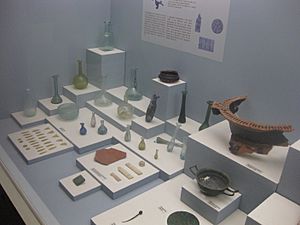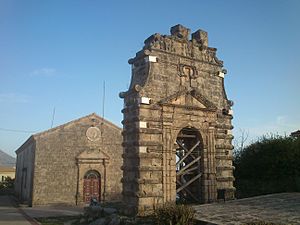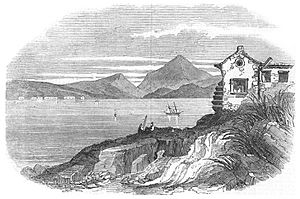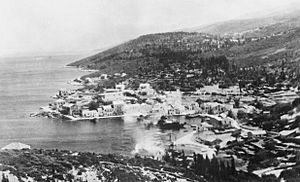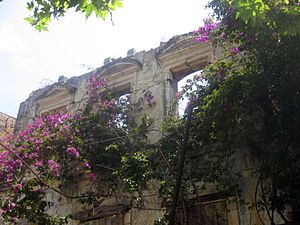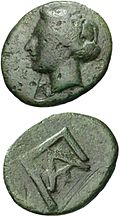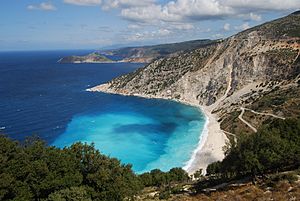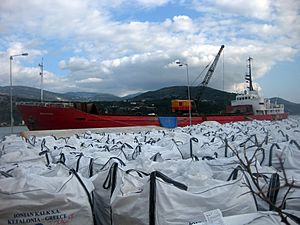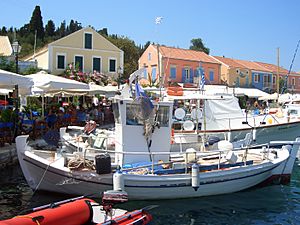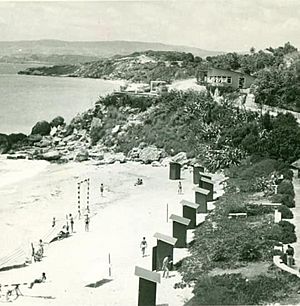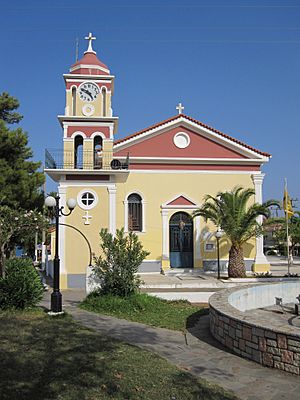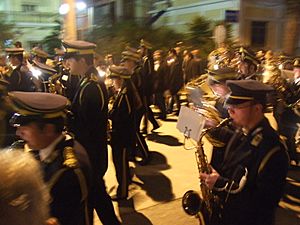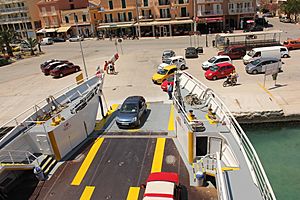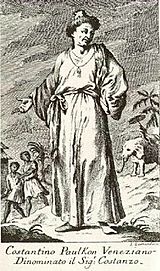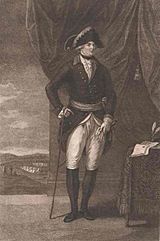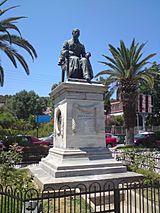Cephalonia facts for kids
Quick facts for kids
Cephalonia
Περιφερειακή ενότητα
Κεφαλληνίας |
|
|---|---|
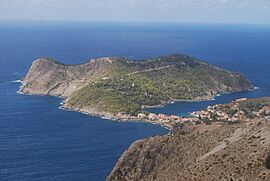
View of Asos
|
|
| Country | Greece |
| Administrative region | Ionian Islands |
| Area | |
| • Total | 773 km2 (298 sq mi) |
| Elevation | 1,628 m (5,341 ft) |
| Population
(2021)
|
|
| • Total | 36,064 |
| • Density | 46.655/km2 (120.83/sq mi) |
| Time zone | UTC+2 (EET) |
| • Summer (DST) | UTC+3 (EEST) |
| Postal code |
280 xx
|
| Area code(s) | 267x0 |
| Vehicle registration | ΚΕ |
Kefalonia or Cephalonia (Greek: Κεφαλονιά) is the largest of the Ionian Islands in western Greece. It is the 6th largest island in Greece overall. The main city on Cephalonia is Argostoli.
Contents
History of Cephalonia
Ancient Times: Legends and Cities
What's in a Name?
Long ago, people believed the island got its name from a mythical hero named Cephalus. He helped a king from Mycenae win a war. As a reward, he received the island of Same, which then became known as Cephalonia.
Some even think Cephalonia might be the real Homeric Ithaca, the home of the famous hero Odysseus. This idea suggests that a part of Cephalonia, called Paliki, was once a separate island.
Early Greek Cities
From about 600 BC, Cephalonia had four main city-states: Pale (now Lixouri), Cranii (near Argostoli), Same (now Sami), and Pronnoi. Each city made its own coins and built impressive temples and forts.
These cities were involved in important events in ancient Greece. For example, 200 soldiers from Pale fought alongside other Greeks against the Persians in the Battle of Plataea. All four cities also teamed up with Athens during the Peloponnesian War. Cephalonia was important because it was close to the entrance of the Bay of Corinth.
Roman Rule
After the Peloponnesian War, the cities of Cephalonia stayed close to Athens. Later, the island became part of the Aetolian League. This led to invasions by the Macedonian king Philip V in 218 BC, and then by the Romans in 189 BC. The Romans conquered Same after a long fight. After this, Cephalonia became less important and its economy slowed down.
Middle Ages: Byzantine and Venetian Rule
In the later Roman Empire, Cephalonia was part of a Roman province. It became a very important base for the Byzantine Empire because it helped stop raids by Muslims and was a bridge for trips to Italy.
Around the 8th century, Cephalonia became the center of a special Byzantine region called the Theme of Cephallenia. The capital moved to the Castle of Saint George, which was safer.
Later, in 1185, the island was taken over by the Normans. It then became part of a special county under the Kingdom of Sicily and was also influenced by Venice. In 1479, the Ottoman Empire took control.
Venetian Period
Turkish rule didn't last long. In 1500, a Spanish-Venetian army captured Cephalonia. After this, many people from other Venetian areas, like Crete, moved to the island.
Cephalonia and nearby Ithaca remained part of the Venetian Republic until it ended in 1797. The Venetians built the Assos Castle in 1596, which is a popular tourist spot today. From the 16th to 18th centuries, the island was a major exporter of currants (a type of dried grape). Its towns were often built on hilltops to protect against pirate attacks.
French, Ionian State, and British Rule
When France conquered Venice in 1797, Cephalonia became a French territory. But in 1798, a combined Russian and Turkish fleet took the islands from the French. From 1799 to 1807, Cephalonia was part of the Septinsular Republic, protected by Russia.
In 1807, the islands went back to France. However, in 1809, the British took control. The Treaty of Paris in 1815 made the Ionian Islands a British protectorate. During this time, Colonel Charles Philippe de Bosset built many public works, including the De Bosset Bridge in Argostoli.
Later, Greek groups began to push for the islands to join Greece. By 1848, there were rebellions against British rule. Cephalonia, along with the other Ionian Islands, officially joined Greece in 1864.
World War II and After

During World War II, Cephalonia was occupied by Italian and German forces. In September 1943, after Italy made peace with the Allies, confusion arose. Italian soldiers hoped to go home, but German forces wanted their weapons. The Italians decided to fight the Germans.
After fierce fighting, the Germans took control of the island. Sadly, thousands of Italian soldiers were killed in a tragic event. This event is featured in the book and film Captain Corelli's Mandolin. Peace returned to the island in 1949 after a period of conflict in Greece.
The Big Earthquake of 1953
Cephalonia is located in an earthquake zone. In August 1953, a series of four strong earthquakes hit the island. The most powerful one, on August 12, destroyed almost every house. Only the northern part of the island, like Fiskardo, was spared.
The earthquake was so strong that it lifted the entire island by about 60 centimeters! This disaster caused huge damage, and many people left the island to find new lives elsewhere.
Recent Times

In the 1990s, a large forest fire damaged many trees and bushes on the island. Earthquakes still happen, but most are minor. In 2003 and 2005, small earthquakes caused minor damage. In 2006, a big snowstorm covered the island, causing power outages. Another forest fire occurred in 2007.
In 2011, the eight smaller towns on the island joined together to form one big municipality. In January 2014, another earthquake measuring 5.9 on the Richter magnitude scale caused some injuries and property damage. The airport remained open, but port services had some delays.
Discovering Cephalonia's Past
Cephalonia is a fascinating place for archaeologists. Finds on the island date back 40,000 years! The most important period for the island was the Mycenaean era (around 1500 BC to 1100 BC). The archaeological museum in Argostoli has many important items from this time.
In 1991, a very important Mycenaean Tholos tomb was found near Tzanata. This large tomb, built around 1300 BC, was where kings and important officials were buried. Its size and the treasures found inside suggest that a major Mycenaean town was nearby.
More recently, in 2006, a Roman grave complex was found in Fiskardo. It contained five burial sites, including a large tomb with gold jewelry, glass and ceramic pots, and bronze items. This tomb had never been disturbed! A well-preserved Roman theater was also found nearby.
Some researchers even believe that Paul the Apostle was shipwrecked on Cephalonia in 59 AD, not Malta.
How Many People Live Here?
In ancient times, people lived in four main cities on the island. These cities formed a group called "tetrapolis."
More recently, the population reached its highest point of 70,077 in 1896. However, it slowly decreased in the 20th century. The big earthquake in 1953 caused many people to leave the island. Many moved to other parts of Greece or emigrated to America and Australia. Since then, the population has stayed between 35,000 and 42,000. In 2011, it was 35,801.
| Year | Population |
|---|---|
| 1879 | 68,321 |
| 1896 | 70,077 |
| 1920 | 55,030 |
| 1940 | 58,437 |
| 1961 | 39,793 |
| 1981 | 41,319 |
| 2001 | 34,544 |
| 2011 | 35,801 |
Most people from Cephalonia have surnames ending in "-atos." Also, almost every village name on the island ends in "-ata," like Metaxata and Chavriata.
Geography of Cephalonia
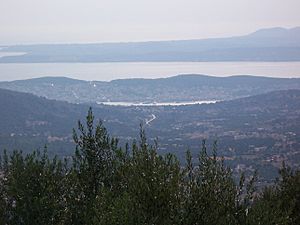
Cephalonia is about 773 square kilometers in size. The town of Argostoli is home to one-third of the island's people. Lixouri is the second largest town.
The island is in an earthquake zone, so small tremors happen often. In 1953, a huge earthquake destroyed most of the island, except for Fiskardo in the north.
Important natural sights include Melissani Lake, the Drogarati caves, and the Koutavos Lagoon in Argostoli. The island has many unique and rare plants and animals. Some areas are protected as part of the European Union's Natura 2000 network.
Mountains and Forests
The highest mountain on the island is Mount Ainos, which is 1628 meters tall. The top of Mount Ainos is covered with fir trees and is a natural park.
Forestry is not very common, but Cephalonia produces more timber than other Ionian islands. Forest fires were frequent in the 1990s and early 2000s and are still a threat.
Capes
- Cape Agios Georgios
- Cape Kounopetra
- Cape Atheras: the north-western tip of the island
Animals of Cephalonia
Cephalonia is famous for its endangered loggerhead sea turtles, also known as Caretta caretta turtles. They lay their eggs on many beaches along the south coast. You can also see these turtles in the waters of Argostoli harbor.
A small group of endangered Mediterranean monk seals also lives around the island's coast, especially in hard-to-reach areas. These caves are perfect for seals to have their babies. Over 200 types of birds have been seen on the island.
Climate
Cephalonia has hot, sunny summers and mild, rainy winters. It has a hot-summer Mediterranean climate. Sometimes, it snows on the mountain peaks in winter. Winter temperatures are usually around 14-15°C during the day. In summer, temperatures are usually around 30°C during the day.
| Climate data for Argostoli (1981–2010) | |||||||||||||
|---|---|---|---|---|---|---|---|---|---|---|---|---|---|
| Month | Jan | Feb | Mar | Apr | May | Jun | Jul | Aug | Sep | Oct | Nov | Dec | Year |
| Mean daily maximum °C (°F) | 14.3 (57.7) |
14.1 (57.4) |
15.7 (60.3) |
18.5 (65.3) |
22.9 (73.2) |
27.0 (80.6) |
29.5 (85.1) |
29.9 (85.8) |
26.9 (80.4) |
23.5 (74.3) |
19.0 (66.2) |
15.5 (59.9) |
21.5 (70.7) |
| Daily mean °C (°F) | 11.3 (52.3) |
11.1 (52.0) |
12.3 (54.1) |
14.9 (58.8) |
19.7 (67.5) |
22.6 (72.7) |
25.1 (77.2) |
25.7 (78.3) |
23.0 (73.4) |
19.9 (67.8) |
15.9 (60.6) |
12.6 (54.7) |
17.8 (64.0) |
| Mean daily minimum °C (°F) | 8.3 (46.9) |
8.0 (46.4) |
9.0 (48.2) |
11.2 (52.2) |
14.5 (58.1) |
18.2 (64.8) |
20.6 (69.1) |
21.6 (70.9) |
19.1 (66.4) |
16.3 (61.3) |
12.8 (55.0) |
9.7 (49.5) |
14.2 (57.6) |
| Average rainfall mm (inches) | 93.1 (3.67) |
100.0 (3.94) |
66.6 (2.62) |
49.7 (1.96) |
20.4 (0.80) |
10.5 (0.41) |
1.3 (0.05) |
5.6 (0.22) |
31.3 (1.23) |
94.7 (3.73) |
155.9 (6.14) |
150.0 (5.91) |
779.1 (30.68) |
| Average rainy days (≥ 1.0 mm) | 9 | 9 | 9 | 5 | 3 | 1 | 0 | 1 | 3 | 7 | 11 | 12 | 70 |
| Source: Meteo-climat-bzh | |||||||||||||
Cephalonia's Economy
In the past, wine and raisins were the main products exported from Cephalonia. Today, fish farming and calcium carbonate are very important. Many Greek shipping families originally came from islands like Cephalonia.
Farming and Food
The main farming activities are raising animals and growing olives. Other crops like grain and vegetables are grown on the flatter parts of the island. Less than a quarter of the island's land is suitable for farming.
Until the 1970s, most Cephalonians lived in the countryside. Now, two-thirds of the population lives in towns.
The island has a long history of making wine, especially a dry, white wine from the Robola grape.
Olive Oil
Making olive oil is a big part of Cephalonia's economy. For a long time, the island only made enough olive oil for its own people. But then, the Venetians encouraged more olive tree planting, and Cephalonia started exporting olive oil.
Before the 1953 earthquake, there were 200 olive oil presses on the island; now there are thirteen. There are over one million olive trees on Cephalonia, covering about 55% of the island. Cephalonian olive oil is known for its green color and rich taste.
Tourism on the Island
Tourism to Cephalonia began in the early 1800s. The Greek royal family even sent their children to Lixouri in the early 1900s. However, most tourists didn't discover the island until the 1980s. Cephalonia is very popular with Italians because it's close to Italy.
Two charming fishing villages, Fiscardo and Assos, attract many visitors. Natural wonders like the Melissani underground lake, Drogarati cave, and Myrtos beach also make Cephalonia popular. The film Captain Corelli's Mandolin (film) (2001), which was filmed on the island, made Cephalonia even more famous.
Culture and Fun
Monasteries and Churches
Cephalonia has two large monasteries. One is Haghia Panagia in Markopoulo. The other is the monastery of Saint Gerasimus of Kefalonia, the island's patron saint. You can see his relics (special religious items) at the old church there. Many beautiful churches on the island survived the earthquakes, some dating back to the Renaissance.
Music and Arts
The Ionian Islands have a special musical style called the Ionian School. Lixouri has a Philharmonic Orchestra that started in 1836. This music was influenced by Italian styles and Western harmonies. A unique type of song called "Cantada" (Serenade) is still very popular.
Many writers have been connected to Cephalonia, including Nikos Kavvadias and Georges Haldas. Lord Byron wrote parts of his poems "Prelude" and "Don Juan" while on the island.
The famous novel Captain Corelli's Mandolin by Louis de Bernières is set on Cephalonia during World War II. The book was made into a film in 2001.
Museums to Visit
- Korgialeneios Museum in Argostoli
- Kosmetatos Foundation in Argostoli
- Archaeological Museum of Argostoli
- Iakovatios-Library (and museum) in Lixouri
- Museum in Fiskardo
- Kefalonia Natural History Museum
- Nautical Museum of Sami
Learning and Sports
Higher Education
- Ionian University, Argostoli Campus (with departments for Food Science and Technology, and Digital Media and Communication)
- Ionian University, Lixouri Campus (with a department for Ethnomusicology)
- National Merchant Marine Academy in Argostoli
- The Music School of Kefalonia – Rokos Vergotis Conservatory in Argostoli
Sports Clubs
- Baseball: AINOS Kefalonia
- Cycling: AINOS Kefalonia podilatikos omilos
- Football (soccer): Many clubs like Anogi F.C., Argostoli A.U., Asteras Lixouri, and Pallixouriakos F.C..
- Other sports: Nautical Racing Club of Kefalonia and Ithaca
Getting Around Cephalonia
Harbors and Ports
You can reach Cephalonia by boat through its five harbors. The main ones are:
- Sami: Connects to Patras and Ithaca.
- Poros: In the south, has ferry routes to Kyllini.
- Argostoli: The largest port, for local boats and ferries to Zante and Lixouri.
- Fiscardo: In the north, connects to Lefkas and Ithaca.
Lixouri is across the bay from Argostoli. There's a ferry that goes between Argostoli and Lixouri every hour (or every half-hour in peak season).
Roads
The first big roads were built by the British in the 1800s. Today, almost all roads connecting villages and beaches are paved. There's a bypass around Lixouri and a four-lane road south of Argostoli.
Public Transport
Buses serve some rural areas, but often only a couple of times a day. The KTEL bus cooperation offers services from Lixouri, Poros, and Argostoli to mainland Greece.
Airport
Cephalonia has one airport, Kefalonia Island International Airport (IATA: EFL). It's about 10 km south of Argostoli. Most scheduled flights are with Olympic Air, mainly to and from Athens. In summer, many charter flights from all over Europe arrive.
How Cephalonia is Governed
Cephalonia is a special regional unit within the Ionian Islands region. Since 2019, it has three municipalities: Argostoli, Lixouri, and Sami. Before 2019, the whole island was one municipality. The main town and administrative center is Argostoli.
The municipality of Argostoli includes the areas of Argostoli, Eleios-Pronnoi, Leivatho, and Omala. The municipality of Sami includes Erisos, Pylaros, and Sami. The municipality of Lixouri covers the area of Paliki.
The Cephalonia regional unit also includes some uninhabited islands in the Echinades group.
Famous People from Cephalonia
- Cephalus: A hero from Greek mythology.
- Odysseus: The legendary king of Ithaca, believed by some to be connected to Cephalonia.
- Juan de Fuca (Ioannis Phokas) (1536–1602): A captain and explorer.
- Constantine Phaulkon (1647–1688): An adventurer who became a chief advisor to the King of Ayutthaya.
- Giacomo Pylarini (1659–1718): A doctor who helped develop early smallpox vaccinations.
- Ilias Miniatis (1669–1714): A clergyman and writer from Lixouri.
- Andreas Metaxas (1786–1860): A Prime Minister of Greece.
- Panayis Athanase Vagliano (1814–1902): A merchant and shipowner, known as the father of modern Greek shipping.
- Photinos Panas (1832–1903): An ophthalmologist who established an eye clinic in Paris.
- Ioannis Metaxas (1871–1941): A General and Prime Minister of Greece.
- Spyridon Marinatos (1901–1974): A famous archaeologist.
- Nikos Kavvadias (1910–1975): A poet and author.
- Anna Pollatou (1983–2014): A rhythmic gymnast who won a bronze medal at the 2000 Summer Olympics.
Images for kids
See also
 In Spanish: Cefalonia para niños
In Spanish: Cefalonia para niños



